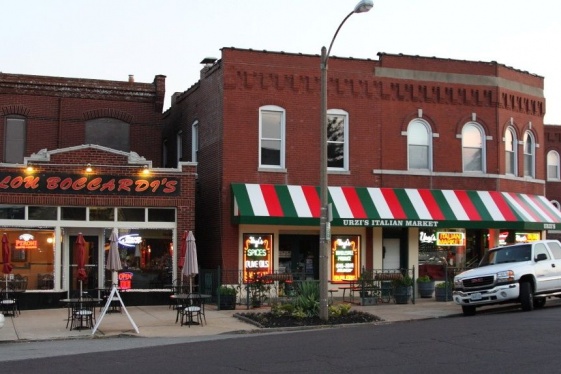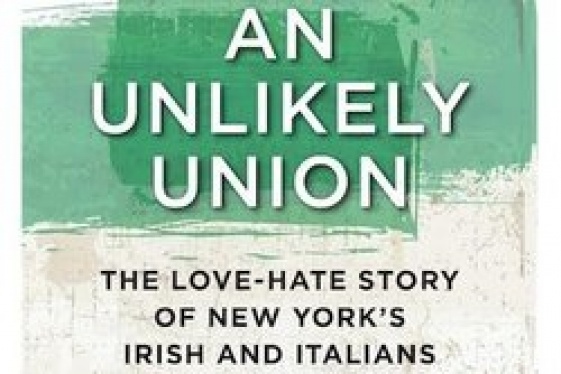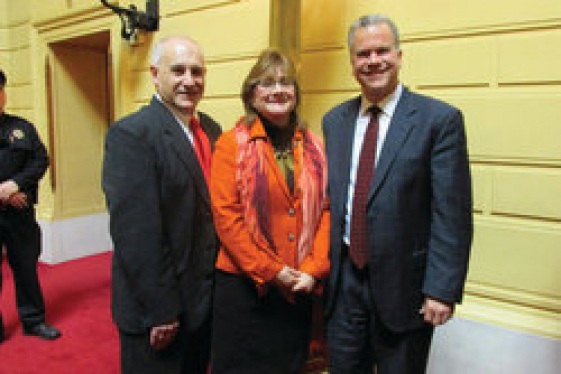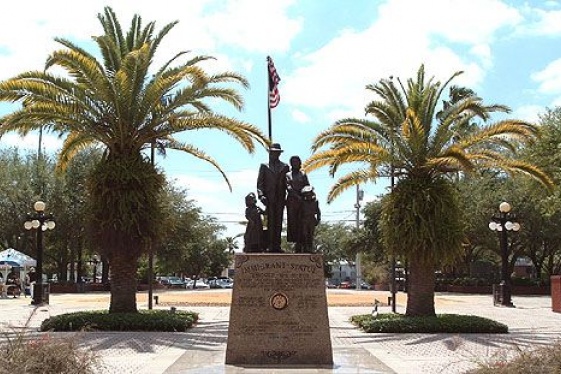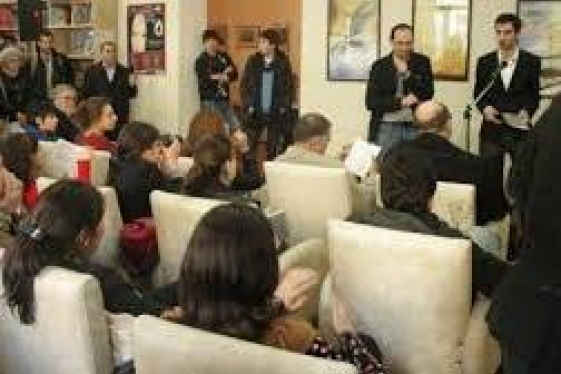
Maddalena Tirabassi (Director of the Centro Altreitalie)
L'emigrazione italiana negli Stati Uniti dopo la seconda guerra mondiale

Italian emigration to America at the end of the XIX and beginning of the XX Century is rightfully the predominant one when dealing with the theme of the Italian diaspora in the United States and more generally in the Americas. Numerically impressive, that emigration is by narrative and description "THE" emigration. But it is not the only time that Italians went to America.
A less studied period, numerically less large, but not for this reason less interesting, is that of the second post-war period. It was certainly a different emigration, but in our opinion fascinating, complex and very important to understand Italian and American societies and the relations between the two countries. No one, in our opinion, can help us to study this phenomenon so rich in cues to understand Italy in America, better than Professor Maddalena Tirabassi . We really thank her very much for what she does, and we welcome her on We the Italians
Doctor Tirabassi, you are the director of the Centro Altreitalie, a wonderful institution that for several years has been dealing with the Italian emigration in the world. First of all I would ask you to describe to our readers the Centro Altreitalie, its activities and its future projects
The history of the Centro Altreitalie is a rather long one, which began in the 1980s within the Giovanni Agnelli Foundation, when a research program on Italians around the world was undertaken. Initially it dealt in particular with Latin America, due to the high concentration of population of Italian origin, collecting documents that were in danger of being lost. During the ‘80s, research was started in Brazil, Argentina and the United States, the results of which were published in three volumes entitled "Euroamericani": it was an important moment, due to the fact that the scholars who dealt with Italian immigration in the world presented their research to the Italian public for the first time.
Towards the end of the '80s the idea of dealing more systematically with Italians in the world matured, and in 1988 the idea of the magazine "Altreitalie" was born. This is where I come in, as I then started my work at the Giovanni Agnelli Foundation to deal with this publication, born from the idea of the then director of the Foundation, Marcello Pacin, from the very beginning.
After working on the project for a year, bringing together scholars of Italian immigration overseas, an international scientific committee was created, with the main scholars and representatives of the centers that dealt with Italians in the world, excluding Africa and Asia. In 1989 the first issue was published.
The magazine was also supported by an important editorial activity of the Foundation, about Italians around the world.
Within this work, the idea of creating a center on Italian migration was also developed. The idea was also encouraged by the interest aroused by the collection of data obtained from the recovery of landing lists, an operation carried out in collaboration with researchers at the nascent Ellis Island Museum. As far as Latin America is concerned, there was collaboration with CEMLA (Center for Latin American Migration Studies) and therefore Argentina and Brazil made their disembarkation lists available.
With the advent of the web, data of Italian emigrants present on the lists of those countries were put online and this attracted not only the interest of politicians and scholars, but also of the descendants themselves who began to search for their origins. In Argentina in particular, because of the dictatorship there was a need for exit channels from the country, and Italian roots were identified as a good tool to trace the documentation that allowed the acquisition of Italian citizenship.
During the '90s it was thus decided to start a real center, which would coordinate the various initiatives, in order to continue the path taken in a more structured way. It expanded from the publications front to conferences and the exchange of scholars, through many scholarships for young people who were interested in Italian migration: some of the best scholars in the field passed through the activities of the Agnelli Foundation in the golden years.
The activities in the 2000s developed also thanks to funding from the Compagnia di San Paolo, which still supports us to a large extent today.
When there was a change in the structure of the Agnelli Foundation, which no longer dedicated itself to these issues, it was decided to incorporate "Altreitalie" within Piero Bassetti's Milanese association "Globus et Locus", with which we had already been in contact for some time, thanks to previous shared research activities, while maintaining our headquarters in Turin in the historic Palazzo D'Azeglio made available to us by the then FIAT group. This synergy of associations and bodies in Turin has allowed the Centro Altreitalie to reach the present day continuing the publication of the magazine and research activities, unfortunately setting aside the granting of scholarships because funding for research has progressively decreased in our country.
We go on also thanks to an important cultural voluntary activity by experts in the field of emigration: researchers, students and PhD students all over the world actively collaborate on the magazine. This has allowed us, in parallel with the coordination activity, an internal research activity on the new Italian emigration since the beginning of the 2000s. In this regard, during the lockdown period we have started a major global investigation on what is happening and will happen to Italian emigration due to the coronavirus.
The issue of the magazine published at the end of June is dedicated to a little explored aspect of the history of Italian migration, despite the enormous development of studies over the last 20 years, namely the thorny problem of violence against women in Italian migration.
The history of Italian emigration to America is complex and very long. I would ask you on this occasion to focus on a particular time window: the one that begins after the end of the Second World War. Who were they, where did they come from, and how were the Italians who emigrated to America after 1945 welcomed?
The period from the end of the Second World War to the present day has still been little studied; as far as Italian emigration in that period is concerned, research has been very focused on Europe and emerging transoceanic countries such as Australia, and Latin America.
There is a lack of analysis: fortunately, two very significant studies have been published in recent years. The first is a volume divided into two parts, by Laura E. Ruberto and Joseph Sciorra: New Italian Migrations to the United States. The first volume deals with Politics and History since 1945, the second volume with Art and Culture since 1945. The other publication is The Routledge History of Italian Americans, edited by William Connell and Stanislao G. Pugliese, published in Italy by Le Monnier Università with the name Storia degli Italoamericani, which I edited.
These volumes also bring out the lexical differences in the two countries; the Italian public tends to identify new Italian emigrations with the end of the 20th century and not with the post-war period, as happens in the United States and as intended by the authors: I think it is important to clarify it in order to avoid misunderstandings. In this regard, I propose here two parallel lines of reading that are that of Italian research and that of other countries, in our case in the United States.
Having said this, I would like to focus on the migratory history of this long period of time, from the end of the Second World War to the present day: scholars agree to divide it into three phases which correspond to different types of immigrants in the United States. Here too, there is a difference in interpretation between Italians, who see this process as emigration, and Americans, who examine it by reconstructing the history of Italian Americans.
The first period goes from 1945 to 1965, the year in which in the United States the Federal Immigration Act repealed the famous quota law which had led to a sharp reduction in southern European immigration, especially Italian, leaving rare windows in which to reach the country. The first period, which coincides with the effects of this law, is characterized by a strong peak of immigration: it goes from a number of 10-15,000 immigrants per year from our country to a peak of 40,000. We must bear in mind that the high numbers were also due to many family reunifications. The liberalization of entry allows this peak, which then settles, and then resumes its trend at the end of the 1960s. This first immigration is defined as traditional, familial, and does not concern many economic immigrants, who instead preferred to migrate mainly to those European countries with which Italy had bilateral agreements.
The second period comes close to the 80s, characterized by a more qualified immigration: these are the years of FIAT in the United States, of multinationals, years in which many professionals start to work abroad, joined also by a not indifferent number of the first Italian researchers or recent graduates through, for example, the Fulbright programs in which I also took part in the 70s. Italians start to go abroad to study, to arrive then to contemporary migrations, where we are on the few thousands per year, not exceeding 5,000.
If the first phase is familiar and economic and the second one is of professionals and some researchers, the third immigration - which starts around 1990 - is that of new mobility or new migrations pushed to leave Italy by a multiplicity of factors.
Does current research provide detailed data about places of departure in Italy and places of arrival in the United States, in these three waves that you mentioned?
Broadly speaking, in the first phase, still linked to the great migration, there is a tendency to go to areas where there was already a presence of Italians, both for reunification and economic migration, and starting mainly from southern Italy. In the second phase, emigration is more homogeneous, although the component from the south is the majority. In the third phase, that of new mobility, according to the statistics there is a migration that starts mainly from the North, even if it is always enhanced by a strong internal South-North Italy immigration.
Is it right to say that the third wave, being not necessarily economic, is not distributed mainly on the two American coasts like the previous ones?
The distribution of new Italian migrations in the United States is not homogeneous and may occur for economic reasons, for study or for a varied component, the most interesting in our object of study. It has, as a condition, the freedom of movement at low cost, at least in the period before the coronavirus, even for the less well-off social categories, especially young people from the North who want to go on an adventure, gain experience, learn the language. But they also move for love, because minority rights are better protected in some countries than in others, as is welfare, which allows women to be better protected to reconcile motherhood and work, for example. All this was the subject of our book published a few years ago entitled: "La Meglio Italia", which contains a first analysis of new migrations.
As for the destination, many people go to New York, even there in a differentiated way: according to the studies of the Italianist Teresa Fiore, a new migrant herself, for example, they go to work in various universities in the United States. Besides, there is a large computer research area in California, in addition to all the connections that are not to be overlooked with all the uncles of America who have an Italian restaurant or pizzeria. Very often these relatives give young Italians jobs, maybe graduates who have no interest or possibility to enter a university setting, to allow them to work for a period abroad and learn English.
Finally, a great mass of people have been moving lately, setting off a wake-up call not only among Italian politicians but also among scholars of migration, concerning the grey band of young people who have moved abroad to study or with a tourist visa, who find themselves with that visa expired at this difficult time, without a job and far from home in Australia or the United States, without funds to be able to return, risking illegality.
Compared to how the ancestors were welcomed at the end of the XIX and during the XX century, I imagine that this emigration, particularly the most recent one, received different treatment in terms of stereotypes from the Americans. Can you please explain this better?
Yes, it is very different, just think that the status of Italians abroad is linked to the image that Italy has at that time on the world stage. For example, during Fascism, Italy initially gained the consensus of the United States, as a result of which Italian Americans acquired a better status, but this opened the way to the “fascistization” of entire Italian communities. Great image benefits came to Italians in America through two other channels: the main one is that of Italy in the 80s, made in Italy, design, fashion and haute cuisine. But in my opinion there is a second, lesser-quoted parallel channel, which has even more distant roots since the Second World War, when during the liberation the Americans arrived in Italy and were struck by the country, to the point that when mass tourism developed, middle to lower income Americans began to travel to Italy. This served to supplant the image of a ragged Italy associated with immigration in the early 1900s, replacing it with one that reflected the prosperity of the boom years. All this had repercussions on the Italian community overseas, as well recounted in some essays in the book The Routledge History of Italian Americans. The Italy of the ‘80s is not that of the emigrants of the beginning of the century or as depicted in some American films, but a modern Italy that was becoming one of the most important world powers, even if for a short period.
Our fellow Italians who arrived in the United States after World War II found an Italian American community that had changed profoundly since the beginning of the century...
It is correct, that community reflects a culture that is neither Italian nor American, but is another culture, a different one of its own, which acquired its own recognition in the 1960s following the struggles for the civil rights of blacks, which opened the way for all other minorities by developing the concept of an America, land of immigration in which all those who had come from the most diverse countries represented a fundamental cog in the construction of the country.
It is generally called "revival of ethnicity". But it is not a revival; it’s the discovery of American ethnicity that abandoned the WASP model to make way for a multi-ethnic society made up of different cultures not to be erased, but to be re-evaluated. In this climate of the '60s and '70s, research was developed on the stories of people who came to the United States through various waves of migration, thus changing the status of Americans of Italian origin who were no longer ashamed to be Italian. It is a generational discourse that has now been profoundly revised: in Sciorra and Ruberto's book it is clear how the renewal of generations with the various waves of migration to the United States delegitimizes the discourse of the "first" or "second" generation as it was developed for the migrations of the early twentieth century.
Is it possible to briefly describe the evolution of the relationship between Italians who arrived in the United States after the 1950s and Italian Americans? Maybe the new technologies have helped?
Through my personal experience, I can see how until the 1970s the idea that Italian Americans represented the culture of southern Italy, frozen at the time of emigration, was widespread. With the '70s, as we have seen, people from other Italian regions began to arrive. These were technicians and professionals who, as far as I know, had relations with the descendants of the first waves of emigration, but for the most part they were limited to visiting restaurants and "ethnic" shops.
In the decades that followed, those who arrived after the Second World War sometimes became part of the process of exodus and abandonment of Little Italy by Italian Americans to the suburbs: think, for example, of the gentrification that took place on Long Island. The depopulation of the ethnic neighborhoods basically allows proximity with the Italians of the second phase, while with regard to the third phase there is a bit of everything: contemporary immigration is separated because it is much more educated and speaks English. But we have seen that there are not only graduates or PhDs, but also unemployed people, who emigrate to the United States because they find themselves with a diploma in their hands and have no chance of working in Italy, especially in the south, and decide to take advantage of cheap flights (at least before the pandemic), to move for example to Berlin or New York, where there is an uncle or relative who can host or support them in the early stages, allowing them to work in their own businesses, mainly in the gastronomy sector. And in this case, old and new migrations meet again.
But there's more to say. If we look at the world of associations, we see that the associations created by Italians, for a long time have had an important problem given by the difficulty of attracting young people; since the associationism of new mobility is on the web and no longer physical, they are going through a moment of deep rethinking. Last year I was lucky enough to participate in a meeting in Palermo, Sicily, organized by CGIE and COMITES where young people from dozens of countries from three continents were gathered. It was a form of association at an institutional level organized by the Italian Ministry of Foreign Affairs, which had succeeded in bringing together young people from different countries and new emigrants in recent years. Well, it was not possible to distinguish "Italian Italians" from third or fourth generation descendants! It was a beautiful experience. This resumption of Italian migrations has therefore sensitized and brought many more young people closer to the topic of migration than 20-30 years ago; many new migrants empathize with the topic, they understand that they are privileged, but they share a series of feelings and experiences due to departure, abandonment, distance, without forgetting the pleasure of discovery and affirmation.
How has Italian emigration in the last seventy years shaped the American society and its various aspects? And how did these new Italian immigrants become integrated and "Americanized"?
Every aspect or almost every aspect of American culture has been affected by the various cultures of the various waves of migration, including the Italian one. There are some sectors, such as gastronomy, where Italians and Chinese have influenced culture in an important way.
The landscape and architecture of US cities have also been profoundly influenced. Also in the United States the Italian contribution to society is particularly relevant in the artistic field, as testified by Regina Soria's research, which lists 350 artists: sculptors and painters, but also stonemasons, marble and wood carvers, figurine makers, plasterers, and bronze artists, in fact anyone working in the figurative arts All these artists played an important role in "shaping" America. For example, some of the American icons were produced by Italians: to be cited are the sculptor of the Capitol, Giuseppe Franzoni, author of the American eagle symbol of the republic; Enrico Causici, sculptor of the first statue in Washington and the busts of Jefferson and Moore; Costantino Brumidi, who introduced the fresco technique in America. The Italian contribution to details is also important: in the buildings of NYC and the various American cities it is not difficult to find stuccoes, mosaics, stained-glass windows, staircase and interior moldings that were made by Italian craftsmen during the period of the art and craft movement. In the subway on 14th street you can still admire the mosaics made by the Italians.
Another aspect in parallel to this is not so much the cuisine, but the way Italians live cities: we invented the squares at the intersection of the streets in the places where we live, thus an open air lifestyle called "Italian way of life" and I can testify to this myself. When I moved from Florence to Turin at the end of the 70s, I saw Turin change from a closed city to a city living on the street: and this was due to immigration from the south to the north in Italy. There were no tables outside Turin, just as there weren't in NYC or in various cities around the world; this is an "Italic" lifestyle, as Piero Bassetti would say, which has been exported to the world.
I find behaviour more important than things, so it is important to export the FIAT brand, but it is also and above all to set an example of how people live in our country. In a recent interview we did for the research we are doing on the effects of the Coronavirus on future mobility, when asked what people abroad thought about the Italians in this crisis, someone talked about how angry Germans were with us because they couldn't come to Italy for holidays. I think this gives a lot of hope for the recovery of our country.
As far as the Americanization of the new Italians who emigrated to the United States is concerned, the thing that emerges is that they are somewhat citizens of the world, and therefore, being their dimension more European than Italian, the discourse of Europeanization or Americanization fades away. The Erasmus generation has been able to enjoy the benefits of the ease of movement and mobility that has developed since the beginning of the second millennium. So much so that at the Palermo conference, what united the young people were the new technologies: they were all together and did not feel different from each other, but paradoxically they felt more different from previous Italian generations.
How would you describe the relationship between the Italy living here and the one made up of 17 million Americans of Italian origin who celebrate its excellence while not living within its borders?
I don't think there is a "they" and "we". We cannot speak of “Italian Americans” because there may be 17 million of them, but they are very different from each other, depending on the periods of immigration and the choices made; there are also those who, for example, never want to be defined as an Italian American or even American of Italian origin, because sometimes the origins are almost forgotten.
Maybe there is the theatrics of the Italian American pizzeria, but then there is also the American art gallery with an Italian, which is visited and appreciated without even knowing his or her ethnic "origin". So the stereotype is fun to keep but it crumbles, in the case of cinema this is obvious: no Italian, watching movies with stereotypical Italian characters thinks they are the reality. It must be said that if for some films Italians are not offended, Italian Americans are, and very much so.
Some people are thinking about a parallel between the emergency that Italy experienced after the Second World War and the one that we are already experiencing and will experience because of the crisis caused by the coronavirus. Obviously there are many differences from many points of view: but can I ask you for a prediction about what could happen about Italian emigration to America?
That's the question we've been asking ourselves lately. From what we have seen so far, probably for the more structured, those who already have a job, there will not be a great change or a return to Italy; on the contrary, as far as the others are concerned, we will have to wait for the next developments, especially with regard to employment. There is no emigration to where there is no possibility of being employed, and this will probably have repercussions, discouraging departures, especially for those who were going for an adventure, because flights will cost much more. One thing that worries many Italians and those who have children studying abroad, concerns family relationships that until a few months ago could be cultivated with great ease. This in the short to medium term will create problems because it will increase costs, there will be quarantines and sometimes double quarantines and families will not be able to reunite. So those who have structured their lives so that they can return to their families on the weekend, not so much in the United States, but in Europe, and then return to work the following Monday, will see their habits changed.
There will be changes in the short term, as there have been in the last three months: and perhaps maintaining transnational family relationships as in the last three decades will be difficult.
You may be interested
-
'Phantom Limb': A Conversation With Dennis...
Dennis Palumbo is a thriller writer and psychotherapist in private practice. He's the auth...
-
“The Hill” St. Louis’ Little Italy
When the fire hydrants begin to look like Italian flags with green, red and white stripes,...
-
An Unlikely Union: The love-hate story of Ne...
Award-winning author and Brooklynite Paul Moses is back with a historic yet dazzling sto...
-
Former Montclair resident turns recipes into...
Former Montclair resident Linda Carman watched her father's dream roll off the presses thi...
-
Polisena delivers address as state lawmakers...
"Italian-Americans came to our country, and state, poor and proud," Johnston Mayor Joseph...
-
The “Little Italies” of Michigan
In doing reseach for this post, I was sure that Italian immigrants found their way to Detr...
-
Ybor City – Florida’s Little Italy
"The people who had lived for centuries in Sicilian villages perched on hilltops for prote...
-
''La Gente di Mulberry Street'' presentato a...
Valsinni- Italia, terra di emigranti. Presentato a Valsinni il nuovo saggio storico di Raf...
















